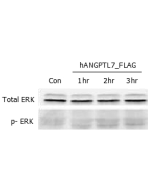Cookie Policy: This site uses cookies to improve your experience. You can find out more about our use of cookies in our Privacy Policy. By continuing to browse this site you agree to our use of cookies.
AdipoGen Life Sciences
anti-ANGPTL7 (human), mAb (Kairos 108-4)

A. Immunoperoxidase staining (cytoplasmic) of formalin-fixed, paraffin-embedded human adrenal gland (200x, brown colour).
B. Isotype control with IgG1 (negative control).
1. hANGPTL7 (FLAG®-tagged).
2. hANGPTL7-FLD protein.
3. hANGPTL7-CCD protein.
4. hVisfatin (FLAG®-tagged) (negative control).
| Product Details | |
|---|---|
| Synonyms | Angiopoietin-like Protein 7; Cornea-derived Transcript 6 Protein |
| Product Type | Monoclonal Antibody |
| Properties | |
| Clone | Kairos 108-4 |
| Isotype | Mouse IgG1κ |
| Immunogen/Antigen | Recombinant human full length ANGPTL7. |
| Application |
ELISA: (direct or indirect: 1:2'000-1:5'000) Note: Tested on recombinant proteins and/or target-protein transfected cell lines in ELISA, Western Blot and/or FACS. |
| Crossreactivity | Human |
| Specificity |
Recognizes human ANGPTL7. Detects a band of ~45kDa by Western blot. Weakly cross-reacts with human ANGPTL7-CCD. |
| Purity Detail | Protein G-affinity purified. |
| Concentration | 1mg/ml |
| Formulation | Liquid. 0.2μm-filtered solution in PBS, pH 7.4. Contains no preservatives. |
| Isotype Negative Control | |
| Shipping and Handling | |
| Shipping | BLUE ICE |
| Short Term Storage | +4°C |
| Long Term Storage | -20°C |
| Handling Advice |
After opening, prepare aliquots and store at -20°C. Avoid freeze/thaw cycles. |
| Use/Stability | Stable for at least 1 year after receipt when stored at -20°C. |
| Documents | |
| MSDS |
 Download PDF Download PDF |
| Product Specification Sheet | |
| Datasheet |
 Download PDF Download PDF |
ANGPTL7 is expressed in various tissues and regulates angiogenesis. Human ANGPTL7 was characterized as a potent target gene of the WNT/ beta-catenin signaling pathway, and is a pharmacogenomics target in the fields of oncology and regenerative medicine. Overexpression of ANGPTL7 increases collagen expression and might exert a pathogenic role in glaucoma.









